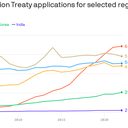Patent applications from Chinese inventors pass U.S. for first time

For the first time, the number of international patents filed from inventors in China has surpassed applications from the U.S., according to a new report.
Why it matters: Patent data is a key indicator of science and technology prowess — and the economic and national security strength that come with it.
- "[We've] never seen a country grow its patenting both at the rate and the volume" as China has, says Robert Atkinson, president of the Information Technology and Innovation Foundation (ITIF).
- It is a "pretty serious indicator" and "should be a wake-up call."
By the numbers: Inventors in China applied for roughly 68,600 patents in 2022 through the Patent Cooperation Treaty, which allows inventors to file across many countries at once, according to a report from the National Science Foundation's National Center for Science and Engineering Statistics (NCSES) published Thursday.
- There were about 58,200 U.S.-based applications the same year — the most recent year for which the data has been compiled.
- Flashback: In 2015, the U.S. had twice as many applications as China, and in 2020 China pulled even with the U.S.
Between the lines: The growth patterns reflect the different growth rates of economies and science and engineering institutions, says report author Carol Robbins, a senior analyst at NCSES. Those rates sped up for some, like China, while others slowed down.
- There's been "resilience in middle income countries and in the developing world over the past several years," Robbins says.
Zoom in: AI-related patents saw tremendous growth. In 2012, AI inventors in China were granted 650 worldwide utility patents — those given for non-obvious inventions. By 2022, that number climbed to more than 40,000.
- U.S.-associated AI patents also grew from about 920 to 9,400 during the same time.
- They encompassed different AI techniques (for example, machine learning), applications (i.e. computer vision or robotics) and fields where they might be used (life sciences, banking and others). This was all before ChatGPT stormed the scene at the end of 2022.
- According to the Congressionally mandated report, China had the highest number of patents in the top three categories of patents issued — machine learning, computer vision, and personal devices and computing.
Caveat: Utility patents are counted from the patents issued in a particular country, and the standard may differ.
- China "systematically over patents and the patents are not necessarily good," Atkinson says.
- One factor is financial incentives in the country to file for patent protection.
Zoom out: For the first time, the biennial report looked at patenting in critical and emerging technologies identified in the CHIPS and Science Act.
- These include AI, advanced materials, semiconductors, quantum information science and tech, and biotech.
- About 190,000 USPTO utility patents were granted in these technologies — about 45% overall were granted to U.S. inventors.
- For many of the fields of technology, the share granted to U.S. inventors was roughly 50%, but for some it was less: 31% for energy-related technologies and 35% for advanced materials.
Yes, but: "Patents are an output, not an outcome," Atkinson says. An abundance of patents doesn't necessarily translate to a successful product or technology.
How it works: The report looks at invention and innovation around the world through several metrics.
- Patents are treated as a reflection of invention at the earliest stages of technology development.
- Trademarking is a measure of the other end of the development pipeline — inventions that have developed into innovations with real-world applications. China's trademark activity in the U.S. grew massively between 2011, when there were about 2,500 trademarks assigned to China, and 2022, when there were more than 120,000.
The big picture: What we're seeing is "not so much of an erosion of capability of the United States but of convergence" as other countries advance, says Dario Gil, director of IBM Research and a member of the National Science Board.
- Instead of focusing on how to address the rest of the world's advances, the emphasis should be on "a renewed commitment to make sure the United States leads" in workforce, patenting, investment, education and innovation, Gil says.
The bottom line: "The competitive environment for tech innovation is way tougher than it was" a decade ago, Atkinson says.